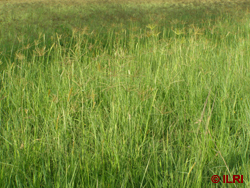Forage grass genetic resources
Contact person for Forage grass: Jean Hanson, ILRI, Ethiopia
Contributors to the section on best practices for management of forage grass genetic resources: ILRI, Addis Ababa, Ethiopia (Jean Hanson, Juvy B. Cantrell, Janice Proud); CIAT, Cali, Colombia (Daniel Debouck, Maritza Cuervo, Rainer Schultze-Kraft); Bioversity International/ILRI, Addis Ababa, Ethiopia (Alexandra Jorge).
External reviewer: Mark van de Wouw (Centre for Genetic Resources, The Netherlands)
Compilation of best practices
Information on genebank management of forage grasses was gathered from current genebank practices, accumulated experience, literature and websites of major forage genebanks (CIAT, ILRI, CSIRO-Australia, IGER-UK, USDA-Fort Collins, EMBRAPA-Brazil) and compiled into tables of procedures. This provided the basic information for selection, justification and recommendations that were then compiled, distinguishing information for seed banks and field banks. This information was finally uploaded onto this website, complemented with relevant photos and revised and validated by the crop experts.
|
|
Importance and origin
Grasses cover a wide range of genera with over 600 species currently used for grazing and livestock feed from about a total of 10 000 grass species that occur in the world. With such a wide range of genera and species, specific conditions and methods are required for each species. These general guidelines are only indicative and specific information should be sought in the literature whenever possible.
Types
Grasses are distributed along the main climatic belts and are classified into major groups, the tropical grasses (Africa is the most important centre of variation in the Gramineae) (Clayton, 1983) and the Mediterranean and temperate grasses (most current utilized grass species were originated from Eurasia, East Africa and South America) (Knight, 1983). Wild species have been distributed widely into South America (Brachiaria decumbens) and Australia (Stylosanthus sp). They vary from annual or perennial, summer-growing or winter-growing ecotypes. In addition to variation between ecotypes, there are also large differences in the agronomic characteristics (as yield) within ecotypes. The taxonomical classification of grasses has posed great challenges, due to their remarkable variation (due to their allogamy, polyploidy, plasmon variability and tillering habits) and there are still a lot of field studies that need to be carried out (Clayton, 1983; Knight, 1983). Most of the Mediterranean and temperate pasture grasses are cross-pollinated. Hybridization and polyploidy are also common features. The cultivars are generally genetic populations, with different gene frequencies (Hayward and McAdam, 1977). There is normally a large genetic variability within species and a poor separation between species (Stebbins, 1972).
Most forage grasses are maintained as seeds except for few shy seeders that rarely produce seeds such as Napier (or elephant) grass (Pennisetum purpureum). These should be maintained in field genebanks. Several forage grasses have seeds which are short-lived and back-up collections are also retained in field genebanks.
Utilization
Forage grasses are used as cut fodder or grazed pastures and also as harvested seed crops (generally from dual purpose food and feed crops). Fodder may be given directly to livestock or after conservation as fermented green matter (silage and haylage) or as a dried product (hay, pellets and cube concentrates).
References and further reading
Bogdan AV. 1977. Tropical Pasture and Fodder Plants, Longman, London.
Cook BG, Pengelly BC, Brown SD, Donnelly JL, Eagles DA, Franco MA, Hanson J, Mullen BF, Partridge IJ, Peters M, Schultze-Kraft R. 2005. Tropical Forages: an interactive selection tool. (www.tropicalforgaes.info) CSIRO, DPI&F(Qld), CIAT and ILRI, Brisbane, Australia.
Clayton WD. 1983. Tropical grasses. In: McIvor JG, Bray RA, editors. Genetic resources of forage plants. CSIRO, Australia. pp. 39-46.
Fairey DT, Hampton JG, editors. 1997. Forage Seed Production, Volume 1: Temperate species. CABI publishing. 416pp.
Hayward MD, McAdam NJ. 1977. Isozyme polymorphism as a measure of distinctiveness and stability in cultivars of Lolium perenne. Zeitschrift für Pflanzenzüchtung 79:59-68.
Knight R. 1983. Mediterranean and temperate grasses. In: McIvor JG, Bray RA, editors. Genetic resources of forage plants. CSIRO, Australia. pp. 48-61.
Loch DS, Ferguson JE, editors. 1999. Forage Seed Production, Volume II: Tropical and subtropical species. CABI publishing, UK.
Maas BL, Hanson J, Robertson LD, Kerridge PC, Moneim AE. 1997. Forages. In: Fuccillo D, Sears L, Stapleton P, editors. Biodiversity in Trust. Cambridge University Press. pp. 322-348.
McIvor JG, Bray RA, editors. 1983. Genetic Resources of Forage Plants. CSIRO, Melbourne, Australia.
Skerman PJ, Riveros F. 1989. Tropical Grasses. FAO Plant Production and Protection Series, No. 23. Food and Agriculture Organization of the United Nations, Rome, Italy.
Stebbins GL. 1972. The Evolution of the grass family. In: Youngner VB, McKell CM, editors. The biology and utilization of grasses. Academic Press, New York. pp 1-17.
Comments
- No comments found





Leave your comments
Post comment as a guest